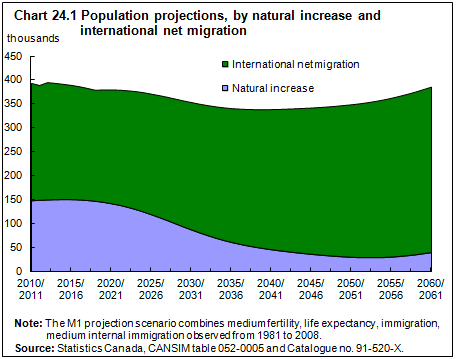Population and demography
Archived Content
Information identified as archived is provided for reference, research or recordkeeping purposes. It is not subject to the Government of Canada Web Standards and has not been altered or updated since it was archived. Please "contact us" to request a format other than those available.
Related information
On July 1, 2010, Canada's population reached an estimated 34.1 million. The population increased by 1.1% from July 2009, a growth rate similar to the annual rates observed since the early 2000s. According to demographic projections, the population will continue to grow over the next 25 years, reaching between 40.1 million and 47.7 million people by 2036.
Population growth
Though down slightly from the previous year, net international migration—the difference between the number of immigrants who came to Canada and the number of emigrants who left—remained an important factor in Canada's population growth. Since the early 2000s, migration has represented about two-thirds of population growth. For the year 2009/2010, net international migration totalled 254,000 people.
The rest of the growth was attributable to natural increase—the difference between the number of births and the number of deaths. In 2009/2010, the natural increase was an estimated 133,800 people with 381,400 births and 247,600 deaths.
According to demographic projections, population growth in the future will be more rooted in international net migration and less in natural increases. In the low-growth scenario, migratory increases alone will contribute to Canada's population growth as early as 2030/2031.
Saskatchewan and British Columbia were the provinces with the highest population growth rates in 2009/2010 (both 1.6%). Alberta (1.4%) and Manitoba (1.3%) also had growth rates above the national average.
Saskatchewan's population growth rate was its fastest since 1971. Though slightly lower than in 2008/2009, the province's net international migration in 2009/2010 contributed to its rapid growth. Saskatchewan's net interprovincial migration was positive for a fourth consecutive year, after being negative for more than 20 years. In 2009/2010, natural increase reached its highest level in the province since 1995/1996.
Alberta posted its slowest population growth rate since 1994/1995 and, for the first time since then, a net loss in interprovincial migration. In contrast to the other provinces, the majority of Alberta's population gain in 2009/2010 was due to natural increase.
Quebec and Ontario, Canada's most populous provinces, had similar growth rates. In both cases, their population increased faster than in previous years.
An aging population
The median age of the Canadian population—the age that divides the population into two equal halves, one older and one younger—has been rising for more than three decades. It was 39.7 years on July 1, 2010, compared with 26.2 years in 1971.
According to the medium-growth scenario in the most recent population projections, the median age will continue to climb and is projected to reach 44.0 years by 2040.
On the basis of median age, Newfoundland and Labrador had the oldest population in the country on July 1, 2010, at 43.3 years, a median age that Canada as a whole is not likely to reach before 2034, according to demographic projections.
On July 1, 2010, the working-age population aged 15 to 64 made up 69% of Canada's population, compared with 63% of the population in 1971. This proportion is expected to decline in the coming years, falling to about 60% of the total population by 2031.
Fast-growing population in the North
In 2009/2010, Nunavut recorded the fastest population growth rate in Canada (3.1%) and the fastest population growth for the territory since 1993/1994. Nunavut's population growth was mainly due to natural increase and, to a lesser extent, interprovincial migration.
In Yukon, the population increase was largely due to international and interprovincial migration. Natural increase contributed less to population growth in Yukon than in the other territories.
Canada's youngest population also resides in Nunavut, where the median age on July 1, 2010 was 24.6 years and people under the age of 15 made up about one-third of the population. The Northwest Territories also has a younger population than the rest of Canada.
- Date modified:

